
应用化学 ›› 2022, Vol. 39 ›› Issue (8): 1224-1236.DOI: 10.19894/j.issn.1000-0518.210500
水性聚硅氧烷和聚乙烯醇复合物制备及其作为皮肤屏障材料的性能
陈炳刚1,3, 刘三荣1, 蒋子江2( ), 于喜飞1,3(
), 于喜飞1,3( )
)
- 1.中国科学院长春应用化学研究所,高分子复合材料工程实验室,长春 130022
2.中国科学院长春应用化学研究所,国家电化学和光谱研究分析中心,长春 130022
3.中国科学技术大学,合肥 230026
-
收稿日期:2021-10-15接受日期:2022-01-20出版日期:2022-08-01发布日期:2022-08-04 -
通讯作者:于喜飞 -
作者简介:zjjiang@ciac. ac. cn -
基金资助:国家自然科学基金项目(21674109)
Preparation and Properties Characterization of Hydrophilic Polysiloxane and Polyvinyl Alcohol Composite as Skin Barrier Material
Bing-Gang CHEN1,3, San-Rong LIU1, Zi-Jiang JIANG2( ), Xi-Fei YU1,3(
), Xi-Fei YU1,3( )
)
- 1.Laboratory of Polymer Composites Engineering,Changchun Institute of Applied Chemistry,Chinese Academy of Science,Changchun 130022,China
2.National Analytical Research Center of Electrochemistry and Spectroscopy,Changchun Institute of Applied Chemistry,Chinese Academy of Science,Changchun 130022,China
3.University of Science and Technology of China,Hefei 230026,China
-
Received:2021-10-15Accepted:2022-01-20Published:2022-08-01Online:2022-08-04 -
Contact:Xi-Fei YU -
About author:xfyu@ciac.ac.cn
-
Supported by:the National Natural Science Foundation of China Project(21674109)
摘要:
皮肤作为人体最外层的器官,容易遭受损伤,构建能够为皮肤提供保护作用的屏障材料具有非常重要的意义。基于皮肤屏障材料性能要求,将亲水改性的聚硅氧烷(PSI)和聚乙烯醇(PVA)相结合,通过原位Ca2+离子交联构建了一种复合多功能的皮肤屏障材料PSI-PVA。研究表明,该材料具有较好的干态和湿态力学性能,以及较好的皮肤相容性、可清洗性、亲水性、透气性、可修饰性和生物相容性。当PVA质量分数为20%时,溶胀率可达149%;随着PVA用量的增加,材料的清洗容易程度提高;紫外吸收剂羟基苯甲酮修饰后,材料的紫外光(200~400 nm)透过率在20%以下,在材料的保护下,小鼠胚胎成纤维细胞(NIH 3T3)在UVB(311 nm)照射后具有较高的存活率(71%)。因此,PSI-PVA可以满足皮肤屏障材料多项性能需求,在皮肤保护和受损修复等领域具有较好的应用前景。
中图分类号:
引用本文
陈炳刚, 刘三荣, 蒋子江, 于喜飞. 水性聚硅氧烷和聚乙烯醇复合物制备及其作为皮肤屏障材料的性能[J]. 应用化学, 2022, 39(8): 1224-1236.
Bing-Gang CHEN, San-Rong LIU, Zi-Jiang JIANG, Xi-Fei YU. Preparation and Properties Characterization of Hydrophilic Polysiloxane and Polyvinyl Alcohol Composite as Skin Barrier Material[J]. Chinese Journal of Applied Chemistry, 2022, 39(8): 1224-1236.

图1 聚硅氧烷和聚乙烯醇复合物作为皮肤屏障材料的制备过程及其特性
Fig.1 Schematic illustration of preparation and properties of skin barrier materials (SBM) based on polysiloxane and PVA composite
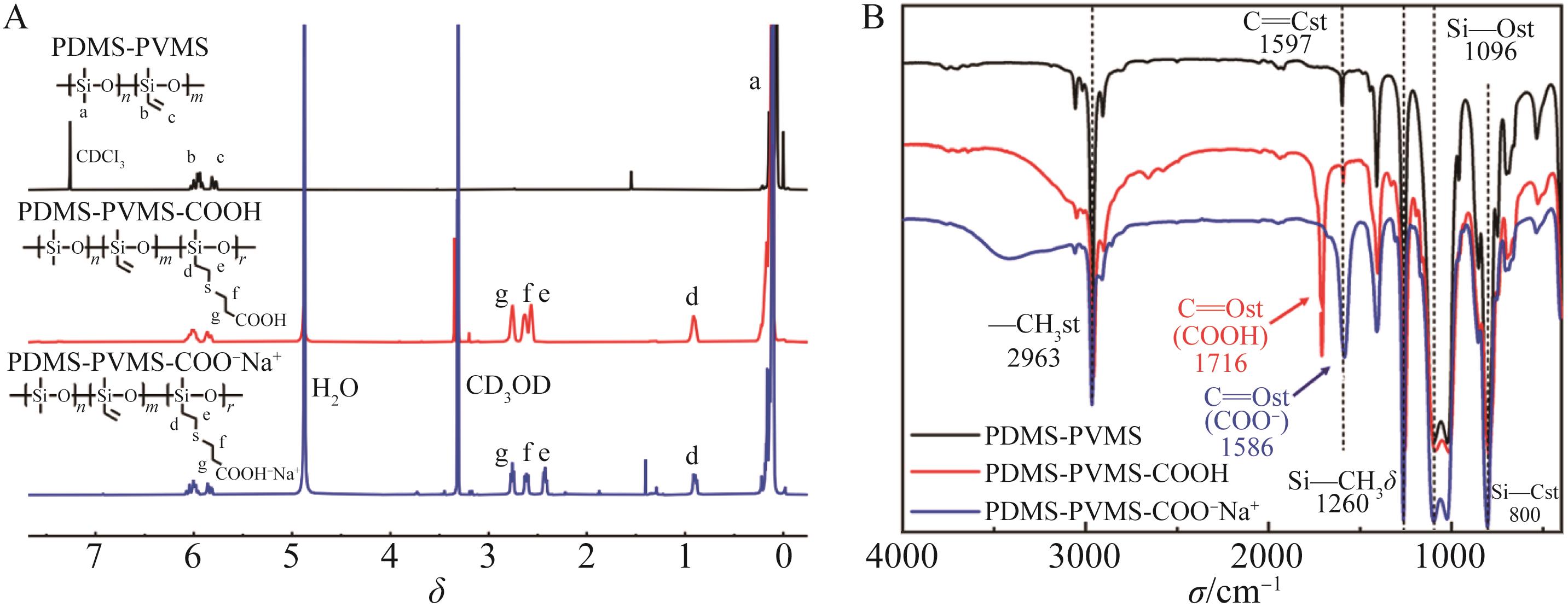
图2 聚硅氧烷PDMS-PVMS, PDMS-PVMS-COOH及PDMS-PVMS-COO-Na+的1H NMR (A)和FT-IR (B)谱图
Fig.2 The 1H NMR (A) and FT-IR (B) spectra of PDMS-PVMS, PDMS-PVMS-COOH and PDMS-PVMS-COO-Na+
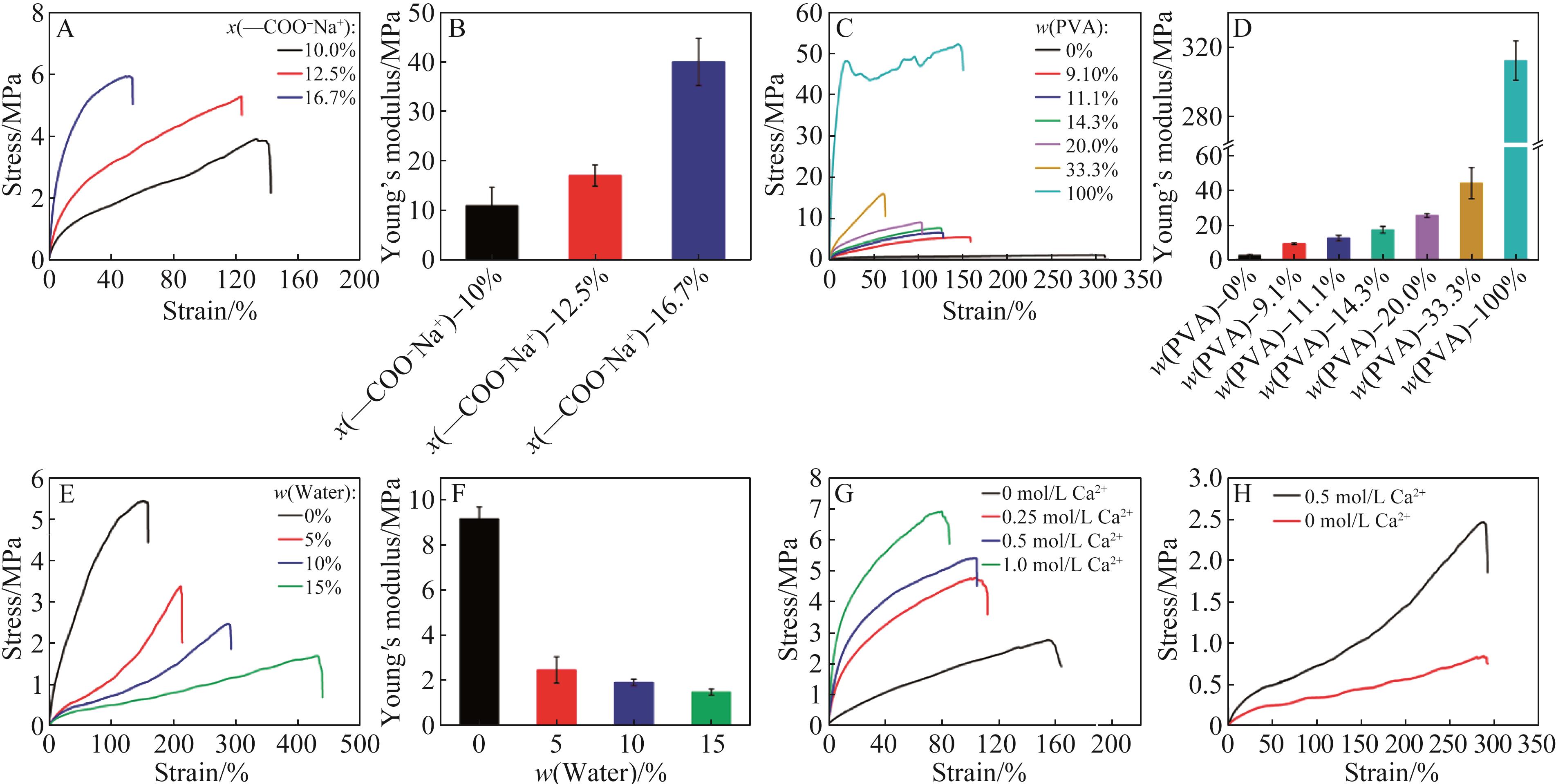
图3 力学性能:不同摩尔分数—COO-Na+修饰的PSI-PVA薄膜的拉伸曲线(A)和杨氏模量(B) (PVA质量分数为9.10%, Ca2+浓度为0.5 mol/L); 不同PVA质量分数下PSI-PVA薄膜的拉伸曲线(C)和杨氏模量(D) (—COO-Na+摩尔分数为10%,Ca2+浓度为0.5 mol/L); 不同含水质量分数下PSI-PVA薄膜的拉伸曲线(E)和杨氏模量(F) (—COO-Na+摩尔分数为10%, PVA质量分数为9.10%, Ca2+浓度为0.5 mol/L); (G)不同Ca2+交联浓度下PSI-PVA薄膜的拉伸曲线(—COO-Na+摩尔分数为10%, PVA质量分数为9.10%); (H)含水质量分数为10%质量分数的PSI-PVA薄膜在有无Ca2+交联下的拉伸曲线(—COO-Na+摩尔分数为10%, PVA质量分数为9.10%)
Fig.3 Mechanical properties: tensile curve (A) and Young's Modulus (B) of PSI-PVA film with different modified ratio of —COO-Na+ (PVA mass fraction was 9.10%, concentration of Ca2+ was 0.5 mol/L); tensile curve (C) and Young's Modulus (D) of PSI-PVA film with different mass fraction of PVA (—COO-Na+ mole fraction was 10%, concentration of Ca2+ was 0.5 mol/L); tensile curve (E) and Young′s Modulus (F) of PSI-PVA film with different content of water (—COO-Na+ mole fraction was 10%, PVA mass fraction was 9.10% and concentration of Ca2+ was 0.5 mol/L); (G) Tensile curve of PSI-PVA film with different concentration of Ca2+ (—COO-Na+ mole fraction was 10%, PVA mass fraction was 9.10% ); (H) Tensile curve of PSI-PVA film with or without Ca2+ crosslinking (—COO-Na+ mole fraction was 10%, PVA mass fraction was 9.10% and water content was 10%)
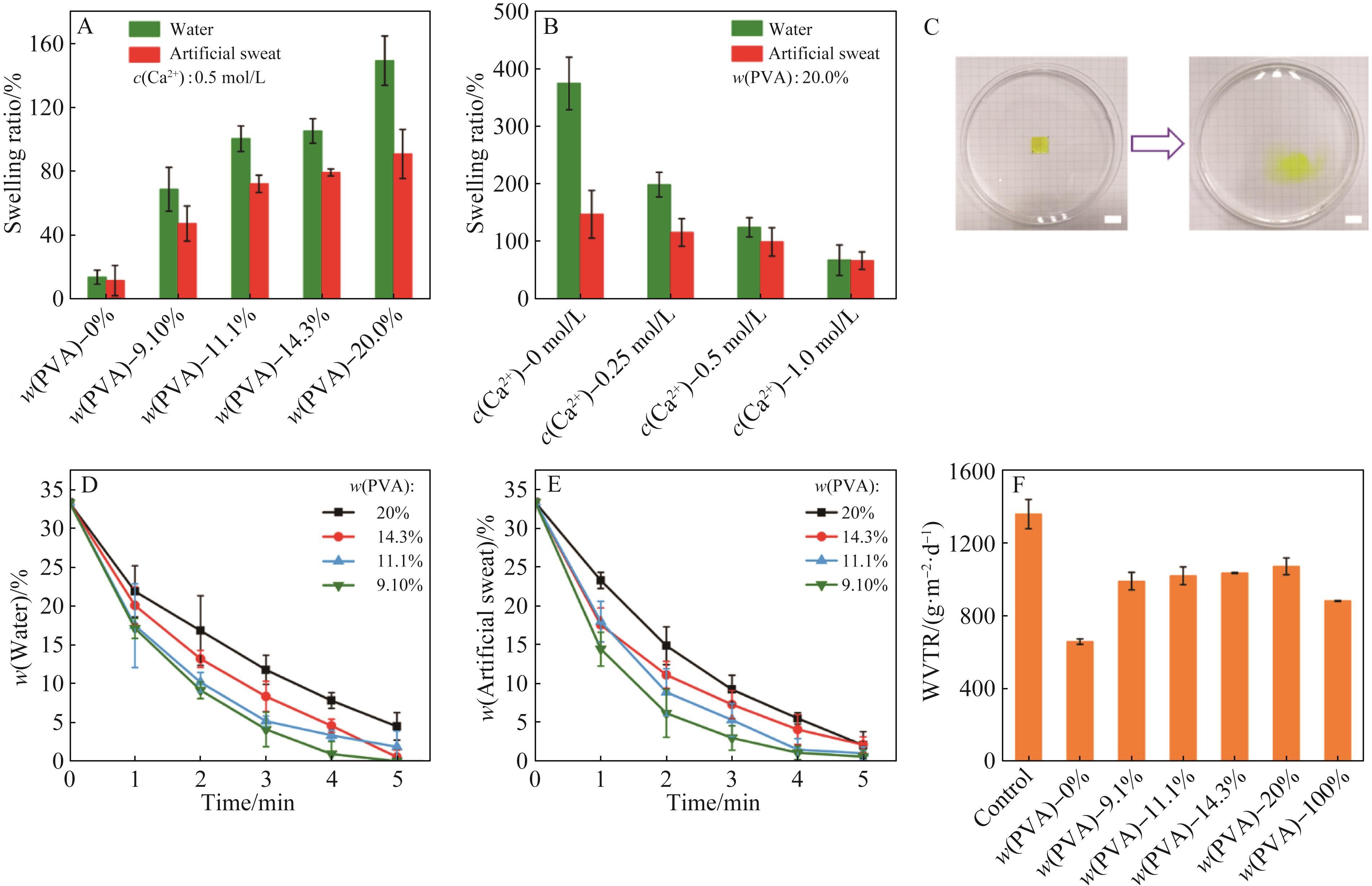
图4 不同PVA质量分数下(A) (Ca2+浓度为0.5 mol/L)和不同Ca2+交联浓度下(B) (PVA质量分数为20%)PSI-PVA薄膜在纯水和人工汗液中的溶胀情况; (C) PVA薄膜(染色后)在纯水中溶胀前后的变化(标尺为1 cm); 不同PVA质量分数下的PSI-PVA薄膜吸收纯水(D)和人工汗液(E)后室温下水含量随时间的变化关系(环境温度18 ℃,相对湿度30%,Ca2+浓度为0.5 mol/L); (F)不同PVA质量分数下PSI-PVA薄膜的水气透过速率(WVTR) (Ca2+浓度为0.5 mol/L)
Fig.4 The swelling ratio of PSI-PVA film in water and artificial sweat with different PVA mass fraction (A) (concentration of Ca2+ was 0.5 mol/L), with different concentration of Ca2+ (B) (PVA mass fraction was 20%); (C) The photograph of PVA film in water (after dyeing, scale bar was 1 cm); The variation of water content with time of PSI-PVA film absorbing water (D) and artificial sweat (E) in room temperature (room temperature was 18 ℃ and relative humidity was 30%, concentration of Ca2+ was 0.5 mol/L); (F) The WVTR of PSI-PVA film with different mass fraction of PVA (concentration of Ca2+ was 0.5 mol/L)
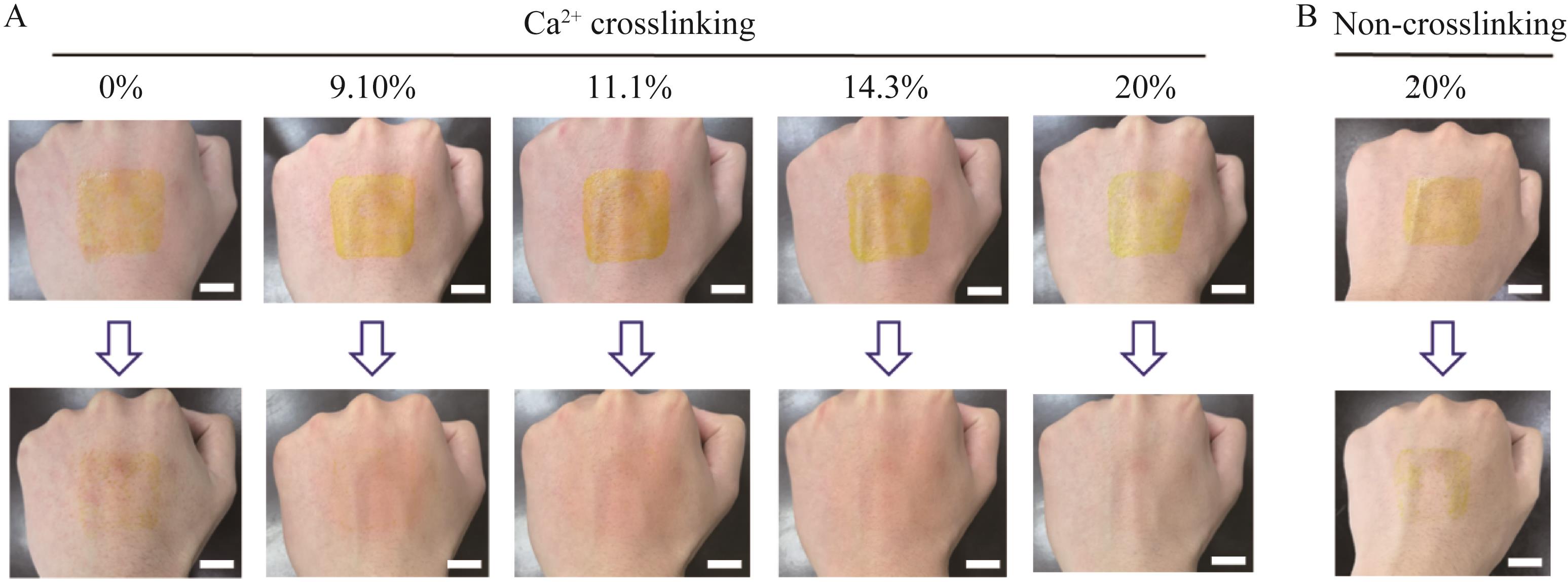
图5 清洗性能: (A) 不同PVA质量分数的PSI-PVA薄膜在Ca2+交联下的的清洗状况; (Ca2+浓度为0.5 mol/L) (B) PVA质量分数为20%的PSI-PVA薄膜未进行离子交联下的清洗状况(标尺为1 cm)
Fig.5 Cleaning properties: the cleaning situation of PSI-PVA film with different mass fraction of PVA after Ca2+ crosslinking (A), with PVA mass fraction of 20% after non-crosslinking (B) (the concentration of Ca2+ was 0.5 mol/L, scale bar was 1 cm)

图6 不同PVA质量分数下PSI-PVA薄膜的SEM形貌 (A) 和水接触角 (B) (Ca2+浓度为0.5 mol/L, 标尺为50 μm)
Fig.6 The SEM morphology (A) and water contact angle (B) of PSI-PVA film with different mass fraction of PVA (the concentration of Ca2+ was 0.5 mol/L, scale bar was 50 μm)

图7 (A) 不同质量分数UV-0修饰的PSI在THF溶液中的紫外吸收性能(0.5 mg/mL); (B) PSI-PVA和PSI(UV)-PVA薄膜的紫外透过性能(薄膜涂覆量为1.2 mg/cm2); 不同涂覆量的PSI-PVA薄膜(C)和PSI(UV)-PVA薄膜(D)的紫外透过性能(PVA质量分数为9.10%, Ca2+浓度为0.5 mol/L)
Fig 7 (A) The UV absorbance of PSI in THF solution (0.5 mg/mL) with different mass fraction of UV-0; (B) The UV transmittance of PSI-PVA and PSI(UV)-PVA film (1.2 mg/cm2); the UV transmittance of PSI-PVA film (C) and PSI(UV)-PVA film (D) with different coating amount (PVA mass fraction was 9.10%, the concentration of Ca2+ was 0.5 mol/L)
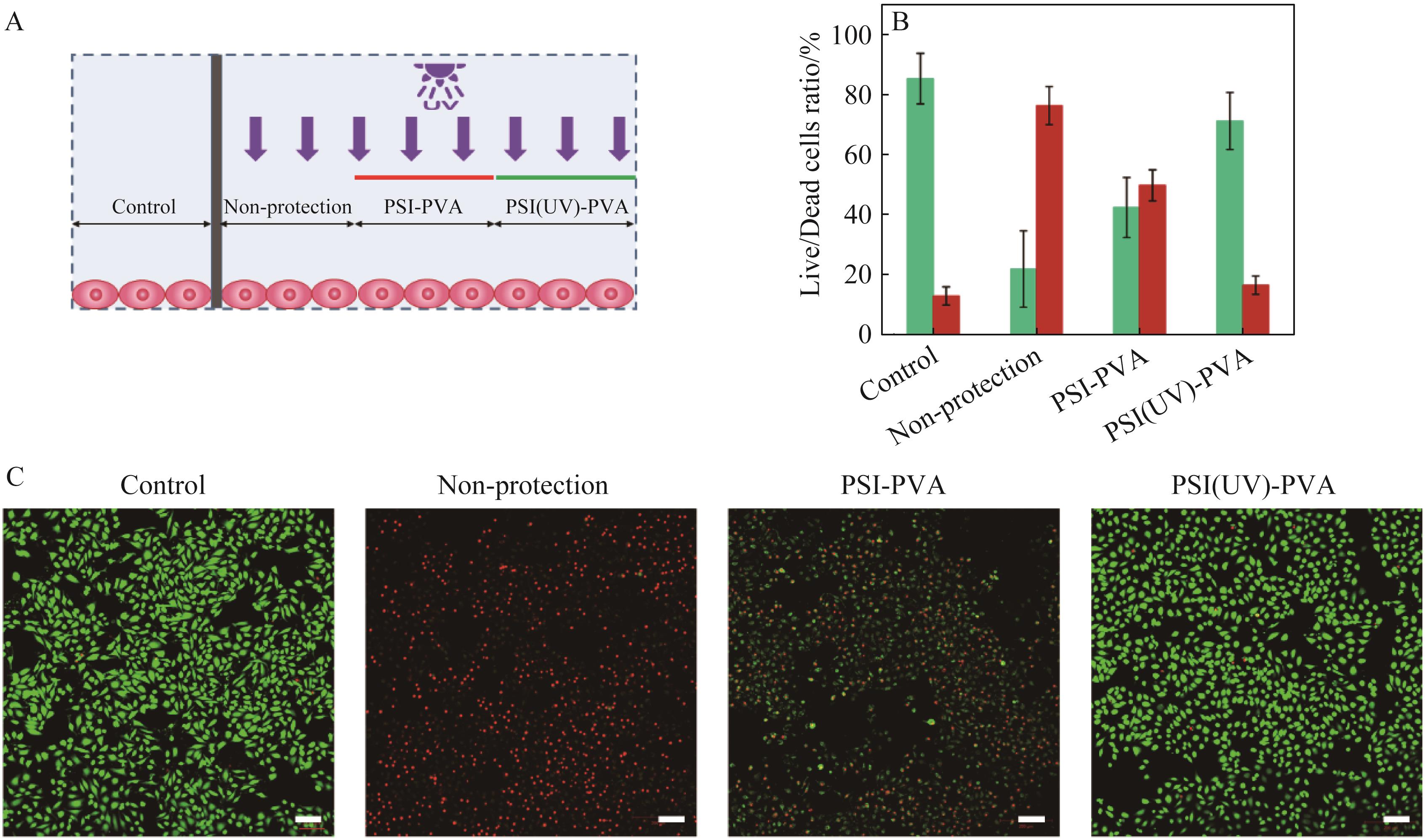
图8 紫外屏蔽性能: (A) 紫外屏蔽性能的体外实验示意图; (B) NIH 3T3细胞在不同保护状态下接受紫外辐射后的细胞活死比例; (C) NIH 3T3细胞在不同保护状态下接受紫外照射后的活死染色图(活细胞呈绿色,死细胞呈红色)(PVA质量分数为9.10%, Ca2+浓度为0.5 mol/L,标尺为100 μm)
Fig.8 Anti-UV properties: (A) the schematic illustration of UV-shielding properties in vitro; the live/dead cell ratio (B) and live/dead stain images (C) of NIH 3T3 cell in different protected situations after UV irradiation (PVA mass fraction was 9.10%, the concentration of Ca2+ was 0.5 mol/L, scale bar was 100 μm)

图9 生物相容性: (A) NIH 3T3细胞在不同PSI-PVA和PSI(UV)-PVA溶液浓度下培养24 h的细胞活性; NIH 3T3细胞在不同样品薄膜上培养24 h后的活死染色: (B) 正常培养 (对照组); (C) PSI-PVA薄膜; (D) PSI(UV)-PVA薄膜 (PVA质量分数为9.10%,Ca2+浓度为0.5 mol/L,标尺为50 μm)
Fig 9 Biocompatibility: (A) The cell viability of NIH 3T3 incubated for 24 h with different concentrations of PSI-PVA and PSI(UV)-PVA solutions; The live/dead stain images of NIH 3T3 cell incubated on different sample films for 24 h: (B) Control; (C) PSI-PVA film; (D) PSI(UV)-PVA film (PVA mass fraction was 9.10%, the concentration of Ca2+ was 0.5 mol/L, scale bar was 50 μm)
| 1 | SHERMAN V R, TANG Y, ZHAO S, et al. Structural characterization and viscoelastic constitutive modeling of skin[J]. Acta Biomater, 2017, 53: 460-469. |
| 2 | SHERMAN V R, YANG W, MEYERS M A, et al. The materials science of collagen[J]. J Mech Behav Biomed Mater, 2015, 52: 22-50. |
| 3 | PISSARENKO A, MEYERS M A. The materials science of skin: analysis, characterization, and modeling[J]. Prog Mater Sci, 2020, 110: 100634-100686. |
| 4 | SUN B K, SIPRASHVILI Z, KHAVARI P A. Advances in skin grafting and treatment of cutaneous wounds[J]. Science,2014, 346: 941-945. |
| 5 | SATO N, KITAHARA T, FUJIMURA T. Age-related changes of stratum corneum functions of skin on the trunk and the limbs[J]. Skin Pharmacol Physiol, 2014, 27: 181-187. |
| 6 | SHEIKHOLESLAM M, WRIGHT M E E, JESCHKE M G, et al. Biomaterials for skin substitutes[J]. Adv Healthc Mater, 2018, 7: 1700897-1700917. |
| 7 | ORYAN A, ALEMZADEH E, MOSHIRI A. Burn wound healing: present concepts, treatment strategies and future directions[J]. J Wound Care, 2017, 26: 5-19. |
| 8 | GIRARD D, LAVERDET B, BUHE V, et al. Biotechnological management of skin burn injuries: challenges and perspectives in wound healing and sensory recovery[J]. Tissue Eng Part B Rev, 2017, 23: 59-82. |
| 9 | BAKER L A, MARCHETTI B, KARSILI T N V, et al. Photoprotection: extending lessons learned from studying natural sunscreens to the design of artificial sunscreen constituents[J]. Chem Soc Rev, 2017, 46: 3770-3791. |
| 10 | D'ORAZIO J, JARRETT S, AMARO-ORTIZ A, et al. UV radiation and the skin[J]. Int J Mol Sci, 2013, 14: 12222-12248. |
| 11 | LAUTENSCHLAGER S, WULF H C, PITTELKOW M R. Photoprotection[J]. Lancet, 2007, 370: 528-537. |
| 12 | 王心蕊, 程慧敏, 唐丽萍, 等. 二维层状离子型纳米材料在化妆品领域的应用进展[J]. 应用化学, 2018, 35(10): 1166-1173. |
| WANG X R, CHENG H M, TANG L P, et al. Applications of two-dimensional layered nanomaterials in cosmetics[J]. Chinese J Appl Chem, 2018, 35(10): 1166-1173. | |
| 13 | SERPONE N, DONDI D, ALBINI A. Inorganic and organic UV filters: their role and efficacy in sunscreens and suncare products[J]. Inorg Chim Acta, 2007, 360: 794-802. |
| 14 | XING J, YUAN D, XIE H, et al. Preparation of efficient ultraviolet-protective transparent coating by using a titanium-containing hybrid oligomer[J]. ACS Appl Mater Interfaces, 2021, 13: 5592-5601. |
| 15 | YOO J, KIM H, CHANG H, et al. Biocompatible organosilica nanoparticles with self-encapsulated phenyl motifs for effective UV protection[J]. ACS Appl Mater Interfaces, 2020, 12: 9062-9069. |
| 16 | DONG Y, CHEN S, ZHOU S, et al. Perspectives on the next generation of sunscreen: safe, broadband, and long-term photostability[J]. ACS Mater Lett, 2019, 1: 336-343. |
| 17 | LOSANTOS R, FUNES-ARDOIZ I, AGUILERA J, et al. Rational design and synthesis of efficient sunscreens to boost the solar protection factor[J]. Angew Chem Int Ed, 2017, 56: 2632-2635. |
| 18 | YAMADA M, MOHAMMED Y, PROW T W. Advances and controversies in studying sunscreen delivery and toxicity[J]. Adv Drug Deliv Rev, 2020, 153: 72-86. |
| 19 | ADAMSON A S, SHINKAI K. Systemic absorption of sunscreen: balancing benefits with unknown harms[J]. JAMA, 2020, 323: 223-224. |
| 20 | WU C, HUANG J, CHU B, et al. Dynamic and hierarchically structured networks with tissue-like mechanical behavior[J]. ACS Nano, 2019, 13: 10727-10736. |
| 21 | YU B, KANG S Y, AKTHAKUL A, et al. An elastic second skin[J]. Nat Mater 2016, 15: 911-918. |
| 22 | BORDE A, LARSSON M, ODELBERG Y, et al. Increased water transport in PDMS silicone films by addition of excipients[J]. Acta Biomater, 2012, 8: 579-588. |
| 23 | BEZUIDENHOUT D, WILLIAMS D F, ZILLA P. Polymeric heart valves for surgical implantation, catheter-based technologies and heart assist devices[J]. Biomaterials, 2015, 36: 6-25. |
| 24 | HAO X, JEFFERY J L, WILKIE J S, et al. Functionalised polysiloxanes as injectable, in situ curable accommodating intraocular lenses[J]. Biomaterials, 2010, 31: 8153-8163. |
| 25 | KUMAR A, HAN S S. PVA-based hydrogels for tissue engineering: a review[J]. Int J Polym Mater Polym Biomater, 2016, 66: 159-182. |
| 26 | CAZÓN P, VELÁZQUEZ G, VÁZQUEZ M. Characterization of bacterial cellulose films combined with chitosan and polyvinyl alcohol: evaluation of mechanical and barrier properties[J]. Carbohydr Polym, 2019, 216: 72-85. |
| 27 | TEIXEIRA M A, AMORIM M T P, FELGUEIRAS H P. Poly(vinyl alcohol)-based nanofibrous electrospun scaffolds for tissue engineering applications[J]. Polymers, 2019, 12: 1-33. |
| 28 | 刘艳, 俞丹, 李维亚, 等. 壳聚糖-聚乙烯醇共混膜在织物化学镀中的应用[J]. 应用化学, 2015, 32(2): 200-206. |
| LIU Y, YU D, LI W Y, et al. Application of chitosan/polyvinyl alcohol complex film in fabrics' electroless plating[J]. Chinese J Appl Chem, 2015, 32(2): 200-206. | |
| 29 | HUANG Y, GUO M, TAN J, et al. Impact of molecular architecture on surface properties and aqueous stabilities of silicone-based carboxylate surfactants[J]. Langmuir, 2020, 36: 2023-2029. |
| 30 | WANG R, WANG X, ZHAN Y, et al. A dual network hydrogel sunscreen based on poly-gamma-glutamic acid/tannic acid demonstrates excellent anti-UV, self-recovery, and skin-integration capacities[J]. ACS Appl Mater Interfaces, 2019, 11: 37502-37512. |
| 31 | JIJI S, UDHAYAKUMAR S, MAHARAJAN K, et al. Bacterial cellulose matrix with in situ impregnation of silver nanoparticles via catecholic redox chemistry for third degree burn wound healing[J]. Carbohydr Polym, 2020, 245: 116573. |
| 32 | SOBHANIAN P, KHORRAM M, HASHEMI S S, et al. Development of nanofibrous collagen-grafted poly(vinyl alcohol)/gelatin/alginate scaffolds as potential skin substitute[J]. Int J Biol Macromol, 2019, 130: 977-987. |
| [1] | 颜丽娟, 高添贺, 施冬健, 陈明清. 丁香酚/改性聚乙烯醇抗菌复合膜的制备与性能[J]. 应用化学, 2023, 40(4): 527-535. |
| [2] | 林渊, 陈嘉炼, 李红周. 单宁酸/聚乙烯醇的阻燃性能[J]. 应用化学, 2023, 40(1): 69-78. |
| [3] | 张守村, 皮茂. 单体对聚乙烯醇乳化行为的影响及大孔材料的制备[J]. 应用化学, 2021, 38(1): 77-83. |
| [4] | 黄刚, 张宏伟, 张欢欢, 石彤非, 许东华. 氧化石墨烯对聚乙烯醇/硼酸水凝胶流变性能的影响[J]. 应用化学, 2018, 35(7): 767-775. |
| [5] | 孙琪, 王丽秋, 刘洋, 郭晨晓, 王鹏君, 刘学龙, 张晓博, 郑立辉, 刘丽萍. 近红外聚乙烯醇荧光高分子材料的制备及性能[J]. 应用化学, 2018, 35(1): 53-59. |
| [6] | 关晓琳, 贾天明, 秦雨欣, 张东海, 张扬, 范红婷, 魏强兵, 来守军. 低温水相合成巯基化聚乙烯醇/CdS量子点纳米复合物及用于测定环境水样中痕量Cu2+[J]. 应用化学, 2017, 34(3): 291-299. |
| [7] | 刘艳, 俞丹, 李维亚, 高翠翠, 王炜. 壳聚糖/聚乙烯醇共混膜在织物化学镀中的应用[J]. 应用化学, 2015, 32(2): 200-206. |
| [8] | 邓新旺, 胡惠媛, 罗仲宽, 吴茂盛, 周莉. 肝素钠/聚乙烯醇复合水凝胶的制备与性能[J]. 应用化学, 2015, 32(12): 1358-1363. |
| [9] | 贾谊, 朱春江, 秦争, 孙勇飞. 低聚端羟基聚硅氧烷接枝增韧酚醛树脂的制备及性能[J]. 应用化学, 2014, 31(05): 566-569. |
| [10] | 范志恒, 周莉, 欧阳君君, 罗仲宽, 李妙妙. 化学-物理法制备聚乙烯醇/壳聚糖/纳米羟基磷灰石复合水凝胶及其性能[J]. 应用化学, 2014, 31(01): 61-64. |
| [11] | 叶文波, 黄世俊, 关怀民, 童跃进. 超疏水聚硅氧烷涂层的制备及其性能[J]. 应用化学, 2012, 29(10): 1123-1129. |
| [12] | 欧阳君君, 周莉. 多孔β-磷酸三钙/壳聚糖/聚乙烯醇复合水凝胶的制备与性能[J]. 应用化学, 2012, 29(09): 995-999. |
| [13] | 赫玉欣, 张玉清. 热塑性淀粉/聚乙烯醇/蒙脱土三元纳米复合材料[J]. 应用化学, 2011, 28(07): 764-769. |
| [14] | 赵水侠, 王来来. 有机硅氧烷预聚体的合成及其在化学固沙中的应用[J]. 应用化学, 2011, 28(07): 753-758. |
| [15] | 姜国民, 赵群, 顾学芳, 张宇, 王绪荣,葛存旺. 亲水性聚硅氧烷改性天然乳胶的性能[J]. 应用化学, 2010, 27(02): 151-154. |
| 阅读次数 | ||||||
|
全文 |
|
|||||
|
摘要 |
|
|||||